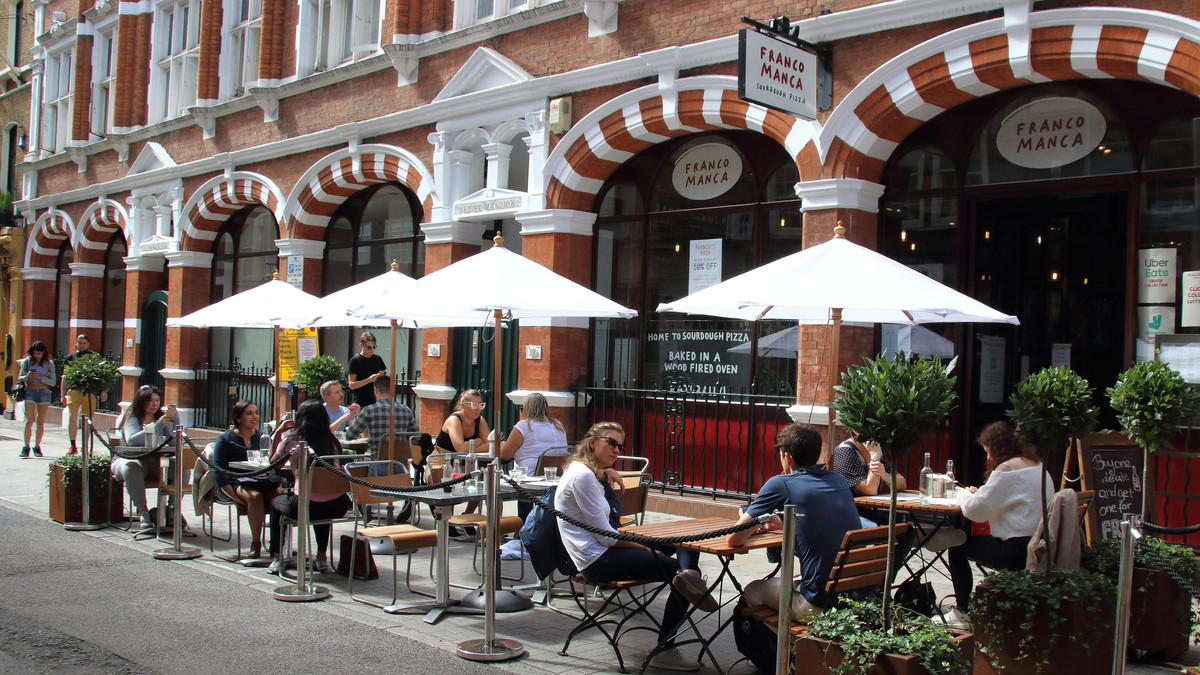On July 4, restaurants in the U.K. opened for business. That weekend saw both customers and workers return to locations that had sat empty for months, with strict social-distancing measures in place. However, almost two months on and these very restrictions, including reduced seating and perspex screens, continue to pose a challenge for the industry. Continued restrictions are predicted to cause restaurants with a large physical footprint a 12 to 17 percent decrease in sales this year, and will hit smaller sites even harder. For an already precarious sector where companies can topple into unprofitability in a moment, the coming months are set to be a trying time.
Many of the biggest names have already struggled to stay afloat through the lockdown period and will be desperate to get people through their doors. Byron Burger, with 52 locations across the U.K., has filed for administration. Restaurants often depend on filling their max capacity on a regular basis to remain commercially viable, and with safety precautions limiting numbers and hesitant customers wary of returning, how can the industry ensure success in spite of challenges?
One sector the restaurant industry can learn from is retail. Already struggling before the pandemic, with continued falling footfall on the high street, many brands have adjusted and adapted how they use their physical locations. With the rise of e-commerce and now limited numbers permitted into stores at one time, many transformed their bricks and mortar stores into “brand shop windows” centered on experiences and services rather than trying to change back to the way things were. From in-store VIP styling appointments to barista classes, John Lewis has been the leading retailer for the past few years in providing its customers with a service that goes beyond the traditional shopping experience. We can expect to see many follow suit.
For those retailers that opened their doors on June 15 in the U.K., those that succeeded clearly demonstrated how far they had adapted in order to protect their customers and cater to their adjusted needs. How can the restaurant industry take these same principles and plan for the new normal?
Explicitly adapt
As lockdown measures begin to lift, it seems there is limited clarity on what measures are enforced, recommended or just optional. This high degree of uncertainty can leave customers hesitant to return to a location they once loved until they have been reassured of its safety.
Before non-essential retail opened in the U.K., retailers such as Primark focused their efforts on how not only to meet the required safety standards, but also demonstrate how they were going above and beyond to keep their customers safe. Clear signage, perspex screens at tills, readily available hand sanitizer and trained staff created a safe experience for customers and employees. Come June 15, stores across the country saw long, socially distanced queues filling high streets, as customers returned to a brand that had managed to gain their trust.
Restaurants can learn from these “theatrical displays of cleanliness” and adapt to suit their situation. They can also innovate to provide customers with options that make them feel comfortable and safe. Deliveroo is launching a new feature called “Table Service” whereby U.K. users will be able to order food and pay ahead of time when having a sit-in meal, reducing unnecessary close contact while still achieving the dining experience.
Reimagined spaces
The greatest issue that restaurants currently face is not being able to host the same number of people as they could pre-pandemic. Chef and restaurateur Jason Atherton says “The big disadvantage of having a restaurant in London is space: the cost of the rent per square foot means that, usually, a restaurant needs to be at 75 percent capacity to make any profit.”
The math here isn’t hard to work out that most restaurants’ profitability sits on a knife’s edge. UKHospitality Chief Executive Kate Nicholls says “Reduction to one-meter (social distancing) should see most venues able to trade at around 70% capacity.” The problem is so great that some restaurants with two-meter distancing would be burning more cash than when they are closed and so will have to wait for restrictions to ease further.
As indoor capacity will be limited to accommodate safety measures, businesses need to re-assess aspects of their locations that were previously unused. From pavements to rooftops, businesses need to start thinking outside the box and completely reconfigure their spaces to help minimize the capacity loss and even create new experiences for their customers. The U.K. has already streamlined the on-street dining application process for pubs and restaurants to better make use of outdoor spaces, so businesses should make sure to look into these initiatives as soon as possible.
New offerings
For the retail industry, many brands adapted to the huge consumer behavior shift driven by lockdown through pivoting online. With a strong digital transformation strategy and a focus on great online experiences, these brands have been able to deliver their products to their customers at home. And for many restaurants, they have already followed suit. Restaurants that previously never delivered have managed to operate a limited service, often with the help of companies like Uber Eats or Deliveroo. Côte Brasserie’s innovative use of geolocation-based Facebook ads allowed them to identify and target its primary market for their restaurant-quality meals and recipes delivery service, Côte at Home.
With many predicting future cycles of lockdowns as the virus returns in waves, providing an adaptable delivery service should be part of the modern restaurant’s model. However, even when physical spaces reopen, restaurants will struggle to remain profitable with delivery and limited capacity dining alone, especially when confronted with substantial rent and bills. Services need to be adapted.
Innovative restaurants have already made these plans. APT, a social-bubble dining experience, lets friends eat a bespoke menu crafted by high profile chefs and restaurants, hosted in an apartment in East London’s Town Hall Hotel. Cooking classes, tasting menus and completely tailored experiences are great new uses of the spaces outside of usual business hours and the expertise at hand to help keep restaurants profitable.
Create an identity and be top of mind
The restaurant industry is driven by reputation. While customers are having much less contact time directly with restaurants, it’s imperative for businesses to create a strong digital identity and be accessible to their customers. Although not necessarily providing an immediate return on investment, creative and engaging content will keep your brand at the front of customers’ minds when they are choosing to dine out.
Top hospitality names like Wagamama and even the Disneyland Parks have released iconic recipes during lockdown for their fans to try to make at home. And beyond these global brands, smaller businesses should make the most of their local knowledge and experience to connect with their neighborhood. After all, most are now aiming to serve their community, rather than impress restaurant critics. This positive association with both brand and product keeps customers connected with these companies.
After what has already been a grueling year for the restaurant industry, the next months aren’t looking any easier. However, hope remains, as consumers have time and time again shown interest in the unbeatable dining experience many companies provide. Success lies in planning now how to implement the highest standard of safety measures, finding ways to safely maintain capacity and create innovative new services to keep customers coming back for more.
This article was written by Grant Powell from Forbes and was legally licensed through the Industry Dive publisher network. Please direct all licensing questions to legal@industrydive.com.
![]()



